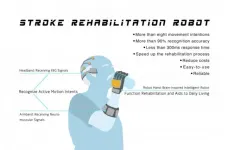Turn off the blue light!
Researchers from University of Tsukuba in collaboration with Yamagata University scientists find that exposure to light with less blue before sleep is better for energy metabolism
2021-07-09
(Press-News.org) Tsukuba, Japan - Extended exposure to light during nighttime can have negative consequences for human health. But now, researchers from Japan have identified a new type of light with reduced consequences for physiological changes during sleep.
In a study published in June 2021 in Scientific Reports, researchers from University of Tsukuba compared the effects of light-emitting diodes (LEDs), which have been widely adopted for their energy-saving properties, with organic light-emitting diodes (OLEDs) on physical processes that occur during sleep.
Polychromatic white LEDs emit a large amount of blue light, which has been linked with many negative health effects, including metabolic health. In contrast, OLEDs emit polychromatic white light that contains less blue light. However, the impact of LED and OLED exposure at night has not been compared in terms of changes in energy metabolism during sleep, something the researchers at University of Tsukuba aimed to address.
"Energy metabolism is an important physiological process that is altered by light exposure," says senior author of the study Professor Kumpei Tokuyama. "We hypothesized that compared with LEDs, OLED exposure would have a reduced effect on sleep architecture and energy metabolism, similar to that of dim light."
To test this hypothesis, the researchers exposed 10 male participants to LED, OLED, or dim light for 4 hours before they slept in a metabolic chamber. The researchers then measured energy expenditure, core body temperature, fat oxidation, and 6-sulfatoxymelatonin--which is a measure of melatonin levels--during sleep. The participants had not recently traveled or participated in shift work.
"The results confirmed part of our hypothesis," explains Professor Tokuyama. "Although no effect on sleep architecture was observed, energy expenditure and core body temperature during sleep were significantly decreased after OLED exposure. Furthermore, fat oxidation during sleep was significantly lower after exposure to LED compared with OLED."
In addition, fat oxidation during sleep was positively correlated with 6-sulfatoxymelatonin levels following exposure to OLED, suggesting that the effect of melatonin activity on energy metabolism varies depending on the type of light exposure.
"Thus, light exposure at night is related to fat oxidation and body temperature during sleep. Our findings suggest that specific types of light exposure may influence weight gain, along with other physiological changes," says Professor Tokuyama.
Many occupations and activities involve exposure to artificial light before sleep. New information about the effects of different kinds of light on physical processes may facilitate the selection of alternative light sources to mitigate the negative consequences of light exposure at night. Furthermore, these findings advance our knowledge regarding the role of light in energy metabolism during sleep.
INFORMATION:
The article, "Metabolic responses to polychromatic LED and OLED light at night" was published in Scientific Reports at DOI: 10.1038/s41598-021-91828-6
The work was supported financially by the Japan Society for the Promotion of Science (KAKENHI grant no. JP 20H04120) and the Japan Science and Technology Agency's Centre for Innovation (grant no. JPMJCE1312). The authors declare no competing interests.
Summary:
Researchers from University of Tsukuba have found that exposure to specific types of light before sleep can have variable effects on energy metabolism during sleep. Specifically, participants who went to sleep after exposure to organic light-emitting diodes (OLEDs), which emit polychromatic white light that contains less blue light than light-emitting diodes (LEDs), exhibited significantly decreased energy expenditure, core body temperature, and increased fat oxidation, indicating fewer negative health consequences compared with after nighttime exposure to LEDs. Thus, OLEDs may be a worthwhile alternative to LED lighting, especially for exposure at night.
[Attachments] See images for this press release:

ELSE PRESS RELEASES FROM THIS DATE:
2021-07-09
Tsukuba, Japan - Scientists from the Division of Physics at the University of Tsukuba used the quantum effect called "spin-locking" to significantly enhance the resolution when performing radio-frequency imaging of nitrogen-vacancy defects in diamond. This work may lead to faster and more accurate material analysis, as well as a path towards practical quantum computers.
Nitrogen-vacancy (NV) centers have long been studied for their potential use in quantum computers. A NV center is a type of defect in the lattice of a diamond, in which two adjacent carbon atoms have been replaced with a nitrogen atom and a void. This leaves an unpaired electron, which can be detected using radio-frequency waves, because its probability of emitting a photon ...
2021-07-09
The discovery of the first high-temperature superconductor in 1986 brought with it the hope that superconductivity would one day revolutionise power transmission, electronic devices and other technologies. Materials that show superconductivity (zero electrical resistance) generally do so at an extremely low temperature. For their use to become widespread and world-changing, we need to develop a material that is superconducting close to room temperature. Research showed that the first high-temperature superconductor - a copper oxide compound - was part of a ...
2021-07-09
Anyone who likes to sing in the shower probably knows that they sometimes sing out of tune. But what about professional singers? How well do they evaluate their own abilities? And what role does this self-assessment play in becoming a better musician? A research team from the Max Planck Institute for Empirical Aesthetics in Frankfurt, New York University, and the University of Hamburg has now investigated these questions scientifically in a study of professional singers.
The study participants, all female sopranos, were each recorded singing "Happy Birthday" in a studio. They were then asked to listen to all of the recordings and rate the pitch accuracy of both their ...
2021-07-09
Babies younger than four weeks old, called neonates, were once thought not to perceive pain due to not-yet-fully-developed sensory systems, but modern research says otherwise, according to researchers from Hiroshima University in Japan.
Not only do babies experience pain, but the various levels can be standardized to help nurses recognize and respond to the babies' cues -- if the nurses have the opportunity to learn the scoring tools and skills needed to react appropriately. With tight schedules and limited in-person courses available, the researchers theorized, virtual e-learning may be able to provide a path forward for nurses to independently pursue training in this area.
To test this hypothesis, researchers conducted a pilot study ...
2021-07-09
Drs. Nobuo Noda (Director) and Tatsuro Maruyama (Researcher) et al. at the Institute of Microbial Chemistry (BIKAKEN, Tokyo, Japan) discovered that lipidated Atg8(1), the most famous factor that mediates autophagy, has membrane perturbation activity and elucidated that this activity is responsible for efficient autophagosome formation.
Autophagosome formation is an essential step in determining the target of degradation in autophagy, which is one of the mechanisms of intracellular protein degradation. It is known that lipidated Atg8 plays a primary role in autophagy processes; however, the molecular function of lipidated Atg8 on the autophagy-related ...
2021-07-09
A new study from Queen Mary University of London has demonstrated that immune cells can be stimulated to assemble into special structures within pancreatic cancer such that, at least in a pre-clinical model, researchers can demonstrate an improvement in the efficacy of chemotherapy.
The body's immune system is a critical defence against illness such as infections, as has been highlighted by the recent COVID-19 pandemic. The same immune system can also help us fight cancer. However, pancreatic cancer is different; a key feature of this cancer type is that the pancreatic cancer cells are surrounded by a dense, impenetrable barrier known as the stroma, which often blocks the access of immune cells to ...
2021-07-09
Coral reefs are a favorite spot for scuba divers and are among the world's most diverse ecosystems. For example, the Hawaiian coral reefs, known as the "rainforests of the sea," host over 7,000 species of marine animals, fishes, birds and plants. But coral reefs are facing serious threats, including a number of diseases that have been linked to human activity.
To understand the connection between human activity and a type of tumorlike disease called growth anomalies (GAs), researchers at the National Institute of Standards and Technology (NIST) have collaborated with the U.S Geological Survey (USGS) and the National ...
2021-07-09
ATLANTA--The American College of Rheumatology (ACR), in partnership with the Vasculitis Foundation (VF), released three new guidelines for the treatment and management of systemic vasculitis. Vasculitis is a group of about 20 rare diseases that have inflammation of blood vessels in common, which can restrict blood flow and damage vital organs. The three guidelines cover six forms of vasculitis, and a fourth guideline on Kawasaki disease will be released in the coming weeks.
"Many rheumatologists may have limited experience caring for patients with these diseases," ...
2021-07-09
Strokes, which occur when the blood supply to part of our brain is interrupted or reduced, are the leading cause of death and disability in the adult population. Among the patients who survive, 75% will experience difficulties carrying out daily activities independently and need long-term functional exercises and rehabilitation. But the outcomes using traditional rehabilitation equipment are poor. In addition, the motivation of patients to train is often low.
The Department of Neurology in Tongji Hospital, which is affiliated to Tongji Medical College at the Huazhong University of Science and Technology, is recognised in China for the quality of its scientific research and clinical strength. Similarly, Zhejiang BrainCo, Ltd., incubated by the Harvard Innovation Lab, is a market ...
2021-07-09
Contrary to conventional thought, songbirds can taste sugar--even though songbirds are the descendants of meat-eating dinosaurs and are missing a key protein that allows humans and many other animals to taste sweetness. An international team investigated how many bird species can taste sweet and how far back that ability evolved. Their work was published today in the journal Science.
The researchers offered two species of songbirds a choice between sugar water and plain water--nectar-taking honeyeaters, as well as canaries, a grain-eating bird not known for consuming sweet foods. They also examined taste receptor responses sampled from a variety of other species. Regardless of whether their main ...
LAST 30 PRESS RELEASES:
[Press-News.org] Turn off the blue light!
Researchers from University of Tsukuba in collaboration with Yamagata University scientists find that exposure to light with less blue before sleep is better for energy metabolism






